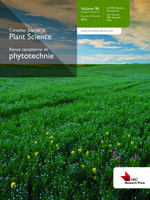Feng, J., Hwang, R., Chang, K. F., Conner, R. L., Hwang, S. F., Strelkov, S. E., Gossen, B. D., McLaren, D. L. and Xue, A. G. 2011. Identification of microsatellite markers linked to quantitative trait loci controlling resistance to Fusarium root rot in field pea. Can. J. Plant Sci. 91: 199-204. Fusarium root rot, caused by Fusarium solani (Mart.) Sacc. f. sp. pisi (F. R. Jones) W. C. Snyder & H. N. Hans, is the most common root disease of field pea (Pisum sativum L.) in western Canada. In this study, a recombinant inbred line (RIL) population (n=71) of field pea, derived from crosses between a resistant cultivar Carman, and a susceptible cultivar Reward, was evaluated to identify quantitative trait loci (QTL) controlling resistance to Fusarium root rot. The parental genotypes and RILs were evaluated for resistance to root rot following inoculation with F. solani in field experiments during 2007 and 2008. The frequency distribution of disease severities among the RILs was continuous. Transgressive segregation for resistance was observed among the RILs, with five lines more resistant than Carman, but no lines were more susceptible than Reward. To identify DNA markers linked with the resistance, 213 microsatellite markers were screened with genomic DNA from the two parental cultivars. Only 14 markers were polymorphic between the two parents and were used to genotype each of the RILs. Quantitative trait loci analysis based on the mean disease severity data from 2007 and 2008 identified a QTL that explained 39.0% of the phenotypic variance in the RIL population. This QTL is flanked by markers AA416 and AB60 on linkage group VII. The microsatellite markers that are closely linked to this QTL may be useful for marker assisted selection to develop cultivars with superior Fusarium root rot resistance.
BioOne.org will be down briefly for maintenance on 12 February 2025 between 18:00-21:00 Pacific Time US. We apologize for any inconvenience.
How to translate text using browser tools
1 January 2011
Identification of microsatellite markers linked to quantitative trait loci controlling resistance to Fusarium root rot in field pea
J. Feng,
R. Hwang,
K. F. Chang,
R. L. Conner,
S. F. Hwang,
S. E. Strelkov,
B. D. Gossen,
D. L. McLaren,
A. G. Xue
ACCESS THE FULL ARTICLE
It is not available for individual sale.
This article is only available to subscribers.
It is not available for individual sale.
It is not available for individual sale.
Fusarium solani
Fusarium solani
locus à caractère quantitatif
pea
pois
pourridié
QUANTITATIVE TRAIT LOCI





